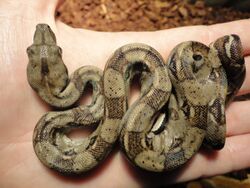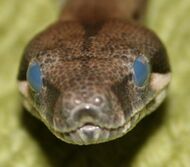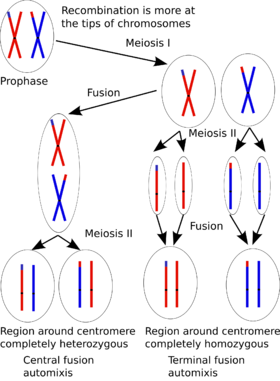Biology:Boa constrictor
| Boa constrictor | |
|---|---|
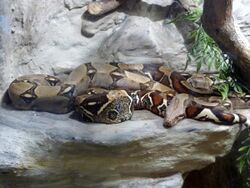
| |
| Scientific classification | |
| Domain: | Eukaryota |
| Kingdom: | Animalia |
| Phylum: | Chordata |
| Class: | Reptilia |
| Order: | Squamata |
| Suborder: | Serpentes |
| Family: | Boidae |
| Genus: | Boa |
| Species: | B. constrictor
|
| Binomial name | |
| Boa constrictor | |
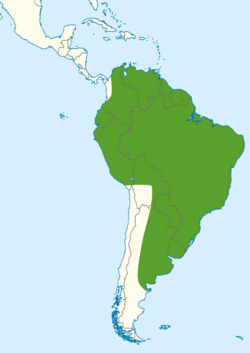
| |
| Distribution[citation needed] | |
| Synonyms[1] | |
| |
The boa constrictor (Boa constrictor), also called the red-tailed boa or the common boa, is a species of large, non-venomous, heavy-bodied snake that is frequently kept and bred in captivity.[2][3] The boa constrictor is a member of the family Boidae, found in tropical South America, as well as some islands in the Caribbean. A staple of private collections and public displays, its color pattern is highly variable yet distinctive. Nine subspecies are currently recognized, although some of these are controversial.[4] This article focuses on the species Boa constrictor as a whole, and on the nominate subspecies B. c. constrictor.
Common names
Though all boids are constrictors, only this species is properly referred to as a "boa constrictor" – a rare instance of an animal having the same common English name and scientific binomial name. (Another such animal is the extinct theropod dinosaur Tyrannosaurus rex.)
All subspecies are referred to as "boa constrictors," and are part of a diverse group of New World boas referred to as "red-tailed" boas, comprising species of both boa constrictor and boa constrictor imperator. Within the exotic pet trade, it is also known as a "BCC," an abbreviation of its scientific name, to distinguish it from other boa species such as B. c. imperator or "BCI."
Other common names include chij-chan (Mayan),[5] jiboia (Latin American), and macajuel (Trinidadian).[6]
Subspecies
Eight subspecies of Boa c. constrictor have been described, but many of these are poorly differentiated, and further research may redefine many of them. Some appear to be based more on location, rather than biological differences.[7] Boa imperator has been elevated to full species status,[8] as well as Boa sigma.[9]
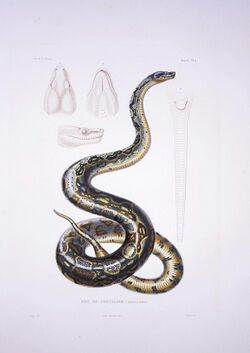
| Subspecies[4] | Taxon author[4] | Common name | Geographic range | Etymology |
|---|---|---|---|---|
| B. c. amarali | Stull, 1932[10] | Amaral's boa[11] | Brazil, Bolivia and Paraguay[12] | The subspecific name amarali is in honor of Brazilian herpetologist Afrânio Pompílio Gastos do Amaral.[11] |
| B. c. constrictor | Linnaeus, 1758 | red-tailed boa | South America[12] | |
| B. c. longicauda | Price & Russo, 1991 | Peruvian long-tailed boa | northern Peru[12] | |
| B. c. melanogaster | Langhammer, 1983 | Ecuadorian boa | Ecuador[13] | |
| B. c. occidentalis | Philippi, 1873 | Argentine boa | Argentina and Paraguay[12] | |
| B. c. orophias | Reichling, 1991[14] | St. Lucia Boa | St. Lucia Island, in the Lesser Antilles[15][16] | |
| B. c. ortonii | Cope, 1878 | Orton's boa[11] | South America[12] | The subspecific name ortonii is in honor of American naturalist James Orton.[11] |
| B. c. sabogae | (Barbour, 1906) | Pearl Island boa | "Pearl Islands" off the coast of Panama[12] |
Several other subspecies have been described at different times, but currently, these are no longer considered to be subspecies by many herpetologists and taxonomists.[13] They include:
- B. c. mexicana (Jan, 1863): this was described from a single specimen which had 55 dorsal scale rows, but otherwise appeared the same as B. imperator. Since then, B. c. mexicana has been included within B. imperator by most authors, as Smith (1963) commented that no Mexican boas have been proven to have 55 dorsal scale rows. However, controversy still exists, as Andrew (1937) reported four Mexican specimens with dorsal scale rows between 56 and 62.[13]
- B. c. eques (Eydoux & Souleyet, 1842): based on a single specimen from Peru that had one large orbital scale; no other such specimens have been found and the snake was probably an aberrant B. imperator.[13]
- B. c. diviniloqua (A.M.C. Duméril & Bibron, 1844): now known to be synonymous with B. c. orophias[13]
- B. c. isthmica (Garman, 1883): considered synonymous with B. imperator, from Panama.[13]
Description
Size and weight
The boa constrictor is a large snake, although it is only modestly sized in comparison to other large snakes, such as the reticulated python, Burmese python, or the occasionally sympatric green anaconda, and can reach lengths from 3–13 ft (0.91–3.96 m) depending on the locality and the availability of suitable prey.[17] Clear sexual dimorphism is seen in the species, with females generally being larger in both length and girth than males. The usual size of mature female boas is between 7 and 10 ft (2.1 and 3.0 m) whereas males are 6 and 8 ft (1.8 and 2.4 m).[18] Females commonly exceed 10 ft (3.0 m), particularly in captivity, where lengths up to 12 ft (3.7 m) or even 14 ft (4.3 m) can be seen.[19] The largest documented non-stretched dry skin is deposited at Zoologische Staatssammlung München (ZSM 4961/2012) and measures 14.6 ft (4.45 m) without head.[20] A report of a boa constrictor growing up to 18.5 ft (5.6 m) was later found to be a misidentified green anaconda.[21]
The boa constrictor is a heavy-bodied snake, and large specimens can weigh up to 27 kg (60 lb). Females, the larger sex, more commonly weigh 10 to 15 kg (22 to 33 lb).[22] Some specimens of this species can reach or possibly exceed 45 kg (100 lb), although this is not usual.[23]
The size and weight of a boa constrictor depends on subspecies, locale, and the availability of suitable prey. B. c. constrictor reaches, and occasionally tops, the averages given above, as it is one of the relatively large subspecies of Boa constrictor.[18]
Other examples of sexual dimorphism in the species include males generally having longer tails to contain the hemipenes and also longer pelvic spurs, which are used to grip and stimulate the female during copulation.[24] Pelvic spurs are the only external sign of the rudimentary hind legs and pelvis and are seen in all boas and pythons.
Coloring
The coloring of boa constrictors can vary greatly depending on the locality. However, they are generally a brown, gray, or cream base color, patterned with brown or reddish-brown "saddles" that become more pronounced towards the tail. This coloring gives B. constrictor species the common name of "red-tailed boas." The coloring works as a very effective camouflage in the jungles and forests of its natural range.
Some individuals exhibit pigmentary disorders, such as albinism. Although these individuals are rare in the wild, they are common in captivity, where they are often selectively bred to make a variety of different color "morphs". Boa constrictors have an arrow-shaped head with very distinctive stripes on it: One runs dorsally from the snout to the back of the head; the others run from the snout to the eyes and then from the eyes to the jaw.[18]
Boa constrictors can sense heat via cells in their lips, though they lack the labial pits surrounding these receptors seen in many members of the family Boidae.[25] Boa constrictors also have two lungs, a smaller (non-functional) left and an enlarged (functional) right lung to better fit their elongated shape, unlike many colubrid snakes, which have completely lost the left lung.
Scalation
Boa imperator has 50–95 dorsal scales, 223–252 ventral scales, 43–69 subcaudal scales, 19–25 supralabial scales and 1–3 anal scales.[26]
Distribution and habitat
Depending on the subspecies, Boa constrictor can be found through South America north of 35°S (Colombia, Ecuador, Peru, Venezuela, Trinidad and Tobago, Guyana, Suriname, French Guiana, Brazil , Bolivia, Uruguay, and Argentina ), and many other islands along the coasts of South America. An introduced population exists in extreme southern Florida,[27] and a small population on St. Croix in the U.S. Virgin Islands now appears to be reproducing in the wild.[citation needed] The type locality given is "Indiis" – a mistake, according to Peters and Orejas-Miranda (1970).[1]
B. constrictor flourishes in a wide variety of environmental conditions, from tropical rainforests to arid semidesert country.[28] However, it prefers to live in rainforest due to the humidity and temperature, natural cover from predators, and vast amount of potential prey. It is commonly found in or along rivers and streams, as it is a very capable swimmer. Boa constrictors also occupy the burrows of medium-sized mammals, where they can hide from potential predators.[18]
Behavior
Boa constrictors generally live on their own and do not interact with any other snakes unless they want to mate. They are nocturnal, but they may bask during the day when night-time temperatures are too low. As semi-arboreal snakes, young boa constrictors may climb into trees and shrubs to forage; however, they become mostly terrestrial as they become older and heavier.[29] Boa constrictors strike when they perceive a threat. Their bite can be painful, especially from large snakes, but is rarely dangerous to humans. Specimens from Central America are more irascible, hissing loudly and striking repeatedly when disturbed, while those from South America tame down more readily.[28] Like all snakes, boa constrictors in a shed cycle are more unpredictable, because the substance that lubricates between the old skin and the new makes their eyes appear milky, blue, or opaque so that the snake cannot see very well, causing it to be more defensive than it might otherwise be.
Hunting and diet
File:Boa Strike-Feeding.ogv Their prey includes a wide variety of small to medium-sized mammals and birds.[29] The bulk of their diet consists of rodents, but larger lizards and mammals as big as ocelots are also reported to have been consumed.[28] Young boa constrictors eat small mice, birds, bats, lizards, and amphibians. The size of the prey item increases as they get older and larger.
Boa constrictors are ambush predators, so they often lie in wait for an appropriate prey to come along, then they attack. However, they have also been known to actively hunt, particularly in regions with a low concentration of suitable prey, and this behavior generally occurs at night. The boa first strikes at the prey, grabbing it with its teeth; it then proceeds to constrict the prey until death before consuming it whole. Unconsciousness and death likely result from shutting off vital blood flow to the heart and brain, rather than suffocation as was previously believed; constriction can interfere with blood flow and overwhelm the prey's usual blood pressure and circulation.[30] This would lead to unconsciousness and death very quickly.[30] Their teeth also help force the animal down the throat while muscles then move it toward the stomach. It takes the snake about 4–6 days to fully digest the food, depending on the size of the prey and the local temperature. After this, the snake may not eat for a week to several months, due to its slow metabolism.[31]
Reproduction and development
Boa constrictors are ovoviviparous, giving birth to live young.[32] They generally breed in the dry season—between April and August—and are polygynous; thus, males may mate with multiple females.[33] Half of all females breed in a given year, and a larger percentage of males actively attempt to locate a mate.[33] Due to their polygynous nature, many of these males will be unsuccessful. As such, female boas in inadequate physical condition are unlikely to attempt to mate, or to produce viable young if they do mate.[33] Reproduction in boas is almost exclusively sexual. In 2010, a boa constrictor was shown to have reproduced asexually via parthenogenesis.[34] The Colombian rainbow boa (Epicrates maurus) was found to reproduce by facultative parthenogenesis resulting in production of WW female progeny.[35] The WW females were likely produced by terminal automixis (see Figure), a type of parthenogenesis in which two terminal haploid products of meiosis fuse to form a zygote, which then develops into a daughter progeny. This is only the third genetically confirmed case of consecutive virgin births of viable offspring from a single female within any vertebrate lineage. In 2017, boa constrictors, along with Boa imperators and Burmese pythons, were found to contain a new set of sex determining chromosomes.[36] Males were discovered to contain a pair of XY sex determining chromosomes, while females have a XX pair.[36] This is the first time snakes were thought to contain male heterogamety, and since then has been found in ball pythons (Python regius) as well.[37]
During the breeding season, the female boa emits pheromones from her cloaca to attract males, which may then wrestle to select one to breed with her.[25] During breeding, the male curls his tail around the female's and the hemipenes (or male reproductive organs) are inserted. Copulation can last from a few minutes to several hours and may occur several times over a few week period.[38] After this period, ovulation may not occur immediately, but the female can hold the sperm inside her for up to one year.[38] When the female ovulates, a midbody swell can be noticed that appears similar to the snake having eaten a large meal.[38] The female then sheds two to three weeks after ovulation, in what is known as a post-ovulation shed which lasts another 2–3 weeks, which is longer than a normal shed.[38] The gestation period, which is counted from the postovulation shed, is around 100–120 days.[38] The female then gives birth to young that average 15–20 in (38–51 cm) in length.[29] The litter size varies between females but can be between 10 and 65 young, with an average of 25, although some of the young may be stillborn or unfertilized eggs known as "slugs". The young are independent at birth and grow rapidly for the first few years, shedding regularly (once every one to two months). At 3–4 years, boa constrictors become sexually mature and reach the adult size of 6–10 feet (1.8–3.0 m), although they continue to grow at a slow rate for the rest of their lives.[7] At this point, they shed less frequently, about every 2–4 months.[39]
Captivity
This species does well in captivity, usually becoming quite tame. It is a common sight in both zoos and private reptile collections. Though still exported from their native South America in significant numbers, they are widely bred in captivity. When kept in captivity, they are fed mice, rats, rabbits, chickens, and chicks depending on the size and age of the individual. Captive life expectancy is 20 to 30 years, with rare accounts over 40 years,[40] making them a long-term commitment as a pet. The greatest reliable age recorded for a boa constrictor in captivity is 40 years, 3 months, and 14 days. This boa constrictor was named Popeye and died in the Philadelphia Zoo, Pennsylvania, on April 15, 1977.[41] Proper animal husbandry is the most significant factor in captive lifespan; this includes providing adequate space, correct temperatures and humidity, and suitable food items.[39]
Up to 41.5% of captive boas test positive for eosinophilic inclusion bodies.[42]
Economic significance
Boa constrictors are very popular within the exotic pet trade and have been both captured in the wild and bred in captivity. Today, most captive boa constrictors are captive-bred, but between 1977 and 1983, 113,000 live boa constrictors were imported into the United States.[7] These huge numbers of wild-caught snakes have put considerable pressure on some wild populations. Boa constrictors have also been harvested for their meat and skins, and are a common sight at markets within their geographic range. After the reticulated python, boa constrictors are the snake most commonly killed for snakeskin products, such as shoes, bags, and other items of clothing.[7] In some areas, they have an important role in regulating the opossum populations, preventing the potential transmission of leishmaniasis to humans.[43] In other areas, they are often let loose within the communities to control the rodent populations.
Conservation
All boa constrictors fall under CITES and are listed under CITES Appendix II, except B. c. occidentalis, which is listed in CITES Appendix I.[44]
In some regions, boa constrictor numbers have been severely hit by predation from humans and other animals and over-collection for the exotic pet and snakeskin trades. Most populations, though, are not under threat of immediate extinction; thus, they are within Appendix II rather than Appendix I.[44]
Boa constrictors may be an invasive species in Florida.[45]
References
- ↑ 1.0 1.1 McDiarmid RW, Campbell JA, Touré TA (1999). Snake Species of the World: A Taxonomic and Geographic Reference Volume 1. Washington, District of Columbia: Herpetologists' League. ISBN:1-893777-00-6 (series). ISBN:1-893777-01-4 (volume).[page needed]
- ↑ Kruzer, Adrienne (May 15, 2018). "Snake Species Commonly Kept as Pets". https://www.thespruce.com/snake-species-1239472.
- ↑ Boa constrictor at the Reptarium.cz Reptile Database. Accessed 7 November 2020.
- ↑ 4.0 4.1 4.2 "Boa constrictor". Integrated Taxonomic Information System. https://www.itis.gov/servlet/SingleRpt/SingleRpt?search_topic=TSN&search_value=209569.
- ↑ Helmke, Christophe (2013). "Mesoamerican Lexical Calques in Ancient Maya Writing and Imagery". The PARI Journal 14 (#2): p. 4. http://www.mesoweb.com/pari/publications/journal/1402/Calques.pdf.
- ↑ Mendes, J. (1986). Cote ce Cote la: Trinidad & Tobago Dictionary. Arima, Trinidad. p. 92.
- ↑ 7.0 7.1 7.2 7.3 Smith, Charles R. (1999). Boa constrictor (Boa constrictor). Siar Anthranir Reptiles
- ↑ CABI Boa Constrictor "CABI", "10/5/2018"
- ↑ Card, Daren C.; Schield, Drew R.; Adams, Richard H.; Corbin, Andrew B.; Perry, Blair W.; Andrew, Audra L.; Pasquesi, Giulia I.M.; Smith, Eric N. et al. (September 2016). "Phylogeographic and population genetic analyses reveal multiple species of Boa and independent origins of insular dwarfism" (in en). Molecular Phylogenetics and Evolution 102: 104–116. doi:10.1016/j.ympev.2016.05.034. PMID 27241629.
- ↑ Stull OG (1932). "Five new subspecies of the family Boidae". Occasional Papers of the Boston Society of Natural History 8: 25–30 + plates 1–2. HTML version available at boa-subspecies.com. Accessed 20 February 2009.
- ↑ 11.0 11.1 11.2 11.3 Beolens, Bo; Watkins, Michael; Grayson, Michael (2011). The Eponym Dictionary of Reptiles. Baltimore: Johns Hopkins University Press. xiii + 296 pp. ISBN:978-1-4214-0135-5. (Boa constrictor amarali, p. 7; B. c. ortonii, p. 196).
- ↑ 12.0 12.1 12.2 12.3 12.4 12.5 "Boa constrictor Page". Boa-constrictors.com. http://www.boa-constrictors.com/com/com.html.
- ↑ 13.0 13.1 13.2 13.3 13.4 13.5 "The Boa Constrictor Subspecies – Melanogaster". Boa-subspecies.com. http://www.boa-subspecies.com/subspecies/melanogaster.htm.
- ↑ Reichling, Steven (1991). "The serpents of St. Lucia, Bothrops caribbae and Boa constrictor orophias". Vivarium 3(3): 7–9;22.
- ↑ Healey, Mariah (2018). "Boa Species & Subspecies" (in en-US). https://reptifiles.com/boa-constrictor-care/boa-species-subspecies/.
- ↑ Daltry, J.C. 2018. Boa orophias. The IUCN Red List of Threatened Species 2018: e.T74866530A75171346. https://dx.doi.org/10.2305/IUCN.UK.2018-2.RLTS.T74866530A75171346.en. Downloaded on 01 May 2021.
- ↑ Maurice, B. International Wildlife Encyclopedia Third Edition. ISBN:0-7614-7266-5[page needed]
- ↑ 18.0 18.1 18.2 18.3 Mattison, C. (2007). The New Encyclopedia of Snakes. Princeton University Press. ISBN:0-691-13295-X.[page needed]
- ↑ Wagner, D. "Boas". Barron's. ISBN:0-8120-9626-6[page needed]
- ↑ Glaw, F.; Franzen, M. (2016). "On the maximum length of Boa constrictor (Serpentes, Boidae)". Spixiana 39 (#2): 264. http://pfeil-verlag.de/wp-content/uploads/2017/05/spix39_2_15.pdf.
- ↑ Murphy JC, Henderson RW. 1997. Tales of Giant Snakes: A Historical Natural History of Anacondas and Pythons. Krieger Pub. Co. ISBN:0-89464-995-7.[page needed]
- ↑ "ANIMAL BYTES – Boa Constrictor". Seaworld.org. http://www.seaworld.org/Animal-info/animal-bytes/animalia/eumetazoa/coelomates/deuterostomes/chordata/craniata/reptilia/squamata/boa-constrictor.htm.
- ↑ Boa Constrictor Fact Sheet – Woodland Park Zoo Seattle WA. Zoo.org. Retrieved on 2012-08-22.
- ↑ O'Shea M (2007). Boas and Pythons of the World. Princeton, New Jersey: Princeton University Press. ISBN:1-84537-544-0.
- ↑ 25.0 25.1 "Boa Constrictor Fact Sheet". Nationalzoo.si.edu. http://nationalzoo.si.edu/Animals/ReptilesAmphibians/Facts/FactSheets/Boaconstrictor.cfm.
- ↑ Lotte, Jose; Lotte, Ben (1996). "Taxonomy and Description of Boa Constrictor". Litteratura Serpentium 16 (#3): 78–81. http://www.snakesociety.nl/jaargangen/1996e/Litteratura%20Serpentium%2016-3%20078-081%20Lotte%20and%20Lotte,%20Taxonomy%20and%20determination%20of%20Boa%20constrictor.pdf. Retrieved 2018-10-22.
- ↑ "Nonnatives – CommonBoa". Florida Fish and Wildlife Conservation Commission. http://myfwc.com/wildlifehabitats/nonnatives/reptiles/common-boa/.
- ↑ 28.0 28.1 28.2 Stidworthy J. 1974. Snakes of the World. Grosset & Dunlap Inc. ISBN:0-448-11856-4.
- ↑ 29.0 29.1 29.2 Mehrtens JM. 1987. Living Snakes of the World in Color. New York: Sterling Publishers. ISBN:0-8069-6460-X.
- ↑ 30.0 30.1 Gill, Victoria (July 23, 2015). "Boa constrictors' lethal secret revealed". BBC News. https://www.bbc.co.uk/news/science-environment-33625080.
- ↑ Montgomery, G. Gene; Rand, A. Stanley (1978). "Movements, Body Temperature and Hunting Strategy of a Boa constrictor". Copeia 1978 (#3): 532–533. doi:10.2307/1443622.
- ↑ Van Dyke, J. U.; Beaupre, S. J. (2012). "Stable isotope tracer reveals that viviparous snakes transport amino acids to offspring during gestation". Journal of Experimental Biology 215 (#5): 760–765. doi:10.1242/jeb.058644. PMID 22323198.
- ↑ 33.0 33.1 33.2 "ADW: Boa constrictor: Information". Animaldiversity.ummz.umich.edu. http://animaldiversity.ummz.umich.edu/site/accounts/information/Boa_constrictor.html.
- ↑ "Who's Your Daddy? Boa Constrictor Has Virgin Birth". LiveScience. 2010-11-03. http://www.livescience.com/animals/first-virgin-birth-boa-constrictors-101103.html.
- ↑ "Consecutive virgin births in the new world boid snake, the Colombian rainbow Boa, Epicrates maurus". Journal of Heredity 102 (#6): 759–63. 2011. doi:10.1093/jhered/esr080. PMID 21868391.
- ↑ 36.0 36.1 Gamble, Tony; Castoe, Todd A.; Nielsen, Stuart V.; Banks, Jaison L.; Card, Daren C.; Schield, Drew R.; Schuett, Gordon W.; Booth, Warren (2017-07-24). "The Discovery of XY Sex Chromosomes in a Boa and Python" (in en). Current Biology 27 (#14): 2148–2153.e4. doi:10.1016/j.cub.2017.06.010. ISSN 0960-9822. PMID 28690112. https://epublications.marquette.edu/cgi/viewcontent.cgi?article=1608&context=bio_fac.
- ↑ Augstenová, Barbora; Johnson Pokorná, Martina; Altmanová, Marie; Frynta, Daniel; Rovatsos, Michail; Kratochvíl, Lukáš (2018-07-04). "ZW, XY, and yet ZW: Sex chromosome evolution in snakes even more complicated". Evolution; International Journal of Organic Evolution 72 (#8): 1701–1707. doi:10.1111/evo.13543. ISSN 1558-5646. PMID 29972583.
- ↑ 38.0 38.1 38.2 38.3 38.4 "Boa Constrictor Care". Ssscales. http://www.ssscales.com/boa_care.html.
- ↑ 39.0 39.1 Stafford, P. 1986. Pythons and Boas. T.F.H. Publications. ISBN:0-86622-084-4.[page needed]
- ↑ Reports[yes|permanent dead link|dead link}}] of an individual living to 40 years in the Philadelphia Zoo.
- ↑ Guinness World Records 2011. Guinness World Records. 2010. p. 63. ISBN 978-1-904994-57-2. https://archive.org/details/guinnessworldrec00/page/63.
- ↑ Chang, L; Fu, D; Stenglein, M.D; Hernandez, J.A; Derisi, J.L; Jacobson, E.R (2016). "Detection and prevalence of boid inclusion body disease in collections of boas and pythons using immunological assays". The Veterinary Journal 218: 13–18. doi:10.1016/j.tvjl.2016.10.006. PMID 27938703.
- ↑ Pough, F. Harvey (2004). Herpetology (third edition). ISBN:0-13-100849-8.[page needed]
- ↑ 44.0 44.1 "Appendices I, II and III". Cites.org. 2009-05-22. http://www.cites.org/eng/app/appendices.shtml.
- ↑ http://www.fort.usgs.gov/FLConstrictors/[full citation needed]
Wikidata ☰ Q215388 entry

